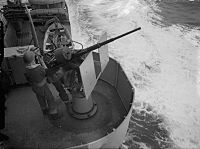HMS Dido (37)
This article includes a list of general references, but it lacks sufficient corresponding inline citations. (April 2009) |
 Dido at anchor
| |
| History | |
|---|---|
| Name | Dido |
| Namesake | Dido |
| Builder | Cammell Laird Shipyard (Birkenhead, UK) |
| Laid down | 26 October 1937 |
| Launched | 18 July 1939 |
| Commissioned | 30 September 1940 |
| Out of service | October 1947 |
| Reclassified | In reserve at Gareloch (between 1947 and 1951) and at Portsmouth between 1951 and 1958 |
| Identification | Pennant number 37 |
| Fate | Scrapped, 18 July 1957 |
| General characteristics (as built) | |
| Class and type | Dido-class anti-aircraft cruiser |
| Displacement | |
| Length | |
| Beam | 50 ft 6 in (15.39 m) |
| Draught | 14 ft (4.3 m) |
| Installed power | 62,000 kW ) |
| Propulsion |
|
| Speed | 32.25 knots (59.73 km/h; 37.11 mph) |
| Range |
|
| Complement | 480 |
| Sensors and processing systems | Type 281 RADAR from September 1940[1] |
| Armament |
|
| Armour | |
HMS Dido was the name ship of her class of light cruisers for the Royal Navy. Constructed by Cammell Laird Shipyard of Birkenhead, United Kingdom, she entered service in 1940 during World War II. The cruiser took part in several battles in the Mediterranean and Arctic theatres of war. Following the war, the ship performed ceremonial functions before being sold for scrapping in 1957.
Construction and career
Dido's
Mediterranean
Dido then spent four months on convoy duty in the Atlantic before running supplies to Malta where she joined the Eastern Mediterranean Fleet in April 1941. In May of that year Dido was sent to Crete and assisted in the evacuation of the British forces. As part of a convoy from Souda Bay to Egypt on 14 May, she carried bullion from Greece worth $7,000,000.[3] On 29 May 1941 Dido was badly damaged by bombs whilst taking troops from Crete to Alexandria.[2] On 8 June 1941, Marines from Dido accepted the surrender of Assab in Eritrea.[2] From July to November 1941, Dido was sent to the Brooklyn Navy Yard in New York City for a refit, rejoining the Eastern Mediterranean Fleet in December 1941.[2] The first three months of 1942 were spent on convoy escort duty between Alexandria and Malta but in March that year, Dido took part in a bombardment of Rhodes. A week later Dido joined the cruisers Cleopatra, Penelope, Carlisle, and Euryalus under the command of Rear Admiral Philip Vian at the Second Battle of Sirte.[2]

On 18 August 1942 Captain H. W. U. McCall brought Dido to
In April 1943, Dido returned to
Arctic
In October 1944, Dido escorted a convoy to Russia before supporting carrier strikes off Norway. In April 1945, Dido escorted
Postwar
In July 1945, Dido took King
Notes
- ^ Macintyre, Donald, CAPT RN "Shipborne Radar" United States Naval Institute Proceedings September 1967 p.75
- ^ a b c d e f g h i j k Jeffs, p. [page needed]
- ^ Thomas 1972 p. 127
- ^ Commander Edward Ellsberg, O.B.E. Under the Red Sea Sun, (1946). Dodd, Mead and Co., New York
- ^ "BBC - WW2 People's War - They Fired the Last Shot".
- ^ Souvenir Programme, Coronation Review of the Fleet, Spithead, 15th June 1953, HMSO, Gale and Polden
Sources
- Campbell, N.J.M. (1980). "Great Britain". In Chesneau, Roger (ed.). Conway's All the World's Fighting Ships 1922–1946. New York: Mayflower Books. pp. 2–85. ISBN 0-8317-0303-2.
- ISBN 978-1-86176-281-8.
- ISBN 978-1-59114-078-8.
- Jeffs, Eric (2005). HMS Dido - A Tiffy's Tale. Arthur H Stockwell Ltd. ISBN 0-7223-3706-X.
- Raven, Alan & Roberts, John (1980). British Cruisers of World War Two. Annapolis, Maryland: Naval Institute Press. ISBN 0-87021-922-7.
- ISBN 1-59114-119-2.
- Thomas, David Arthur (1980) [1972]. Crete 1941: The Battle at Sea. Athens: Efstathiadis Group. OCLC 11023583.
- ISBN 1-86019-874-0.
